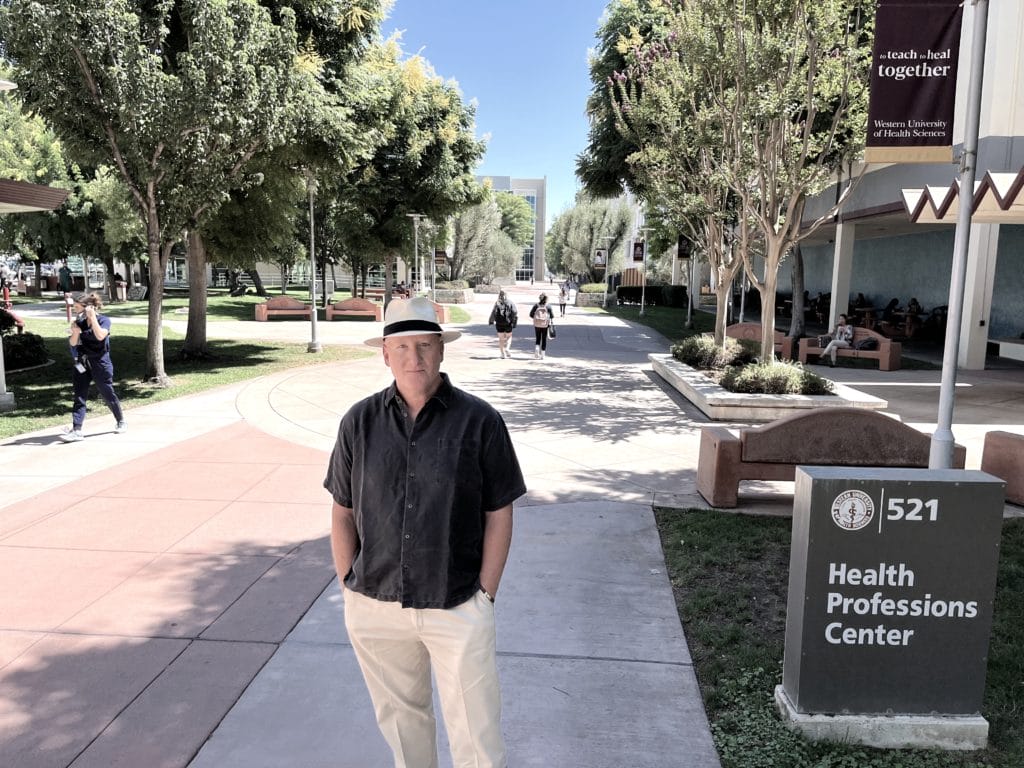One Year and 29 Students Later, A Pioneering Program is Providing Just What the Doctor Ordered

When he was a student in medical school, Andrew Pumerantz wrestled with a challenge familiar to many students.
Time.
But it wasn’t simply not having enough time for family or the other two key factors in every student’s life, sleep and study.
Pumerantz, who directs the Department of Population Health Science at Western University’s College of Osteopathic Medicine of the Pacific (COMP), had other intellectual interests. He especially wanted time to study public health and find a way to integrate it into his training.
The problem was, all medical school programs at the time pushed off getting a master’s in public health “and created huge disincentives that were discouraging to all but the most zealous students,” he explained.
Today, that discouraging situation is changing in large part thanks to a pioneering new program created by Pumerantz that’s central to the partnership between WesternU COMP and CGU’s School of Community & Global Health (SCGH).
Launched in 2021, the SCGH-WesternU DO/MPH Dual Degree Program is already drawing a steady influx of students because of its appealing design and the way it addresses key issues like time and cost.
“We’re giving our students a much better pathway to achieving both degrees,” said Pumerantz, who co-directs the dual degree program with SCGH’s Bree Hemingway. “We’ve lowered some major disincentives. I honestly think if this had existed when I was a student, I would have done my education this way.”
Pumerantz’s vision, said SCGH Dean Jay Orr, demonstrates the kind of “innovative, out-of-the-box thinking that today’s students truly need”
But it didn’t exist when he was in school, and Pumerantz was forced to pursue his master’s in public health—from UC Berkeley—later on when he was already in mid-career.
“It just wasn’t part of people’s consciousness when I was a student,” he said. “No one believed that you could actually handle both programs at the same time.”
For SCGH Dean Jay Orr, that inflexible attitude is changing because of the impact of the COVID-19 pandemic. Today, he said, the public is far more aware and supportive of the need for doctors and other medical professionals to have public health training.
“Frontline health workers have seen a whole new level of complexity since the pandemic began. This complexity demands a more robust response, and Dr. Pumerantz’s vision of the DO/MPH dual enrollment program is the kind of innovative, out-of-the-box thinking that today’s students truly need,” he said. “I’m really thrilled that we’ve been able to partner with WesternU to make this revolutionary program possible.”
Changing the Model
The SCGH-WesternU program gives COMP students a chance to earn a master’s in public health (MPH) at CGU at the same time that they’re working toward their doctor of osteopathic medicine (DO).
Other programs across the country don’t do that. Instead, they add on a very packed, very intensive fifth year so that medical students can get their MPH after completing the four years of their medical school program.
But Pumerantz says that model is highly discouraging. Not only does it add the expense of a fifth year to a student’s academic career, it’s also “condensing a two-year program into a very intensive single year, which just seems crazy to me.”
Instead, Pumerantz envisioned taking the standard two-year timeline commonly required to complete the coursework for an MPH and mapping it out—along with providing a 30% discount in tuition—over the four years of the medical program. By decelerating the MPH program in this way, students can take public health coursework alongside their medical school curriculum.
Pumerantz said SCGH’s faculty moved quickly to approve that design so that it could be offered to incoming WesternU COMP students in the fall of 2021.
The response from students was immediate and positive. First-year students were eager to join the dual degree program, and Pumerantz said that interest was soon echoed by other students already enrolled at the medical school.
“They were saying to me, ‘What about us? Why are you doing this for just incoming first-year students?’ ” said Pumerantz, who was thrilled by that response and pivoted quickly to accommodate it. “We adjusted the program to respond to this interest. We made it possible for students who didn’t start the DO/MPH in their first year to join as second-year medical students and finish the MPH in three instead of four years. The response has been fantastic.”
Whereas the more traditional five-year model at other schools may attract a handful of interested students, the SCGH-WesternU COMP program already has 29 students enrolled—and shows no signs of slowing down.
“We have a great group of students,” he said. “Our cohort is amazing.”
To facilitate even more enrollment in the future, Western U’s medical school general application already incorporates questions about the DO/MPH program to gauge applicant interest and to track these individuals through the entire admissions process. Though still early in this new effort, Pumerantz said he’s already seeing that one in three admitted students are interested, and that bodes well for the program’s future.

Following Suit
In the wake of that success, SCGH also recently announced a partnership with the California University of Science and Medicine (CUSM) to create a similar dual enrollment degree program for CUSM’s medical students.
For SCGH’s Hemingway, students on campuses across the country are recognizing that “the MPH is the gold standard in the field. It’s a vital necessity for any health professional to understand and address health inequities that impact our communities.” (Hemingway holds both an MPH and PhD from CGU.)
Pumerantz isn’t surprised to see the dual enrollment model gaining more traction at other institutions. Long before the rise of Covid-19, he said he was already thinking of this kind of program to compensate for gaps in most medical school training that prevent doctors from seeing the big picture of sickness and disease.
Those gaps were a significant catalyst behind Pumerantz’s effort to create the Department of Population Health Science. Creating that department is an example of what he calls a “reconvergence” that’s vitally needed between public health training and medical school.
“We have to create a new way of thinking. We have to think differently about the health of individuals and populations,” he explained. “You have to think on multiple layers about communities and how they’re affected, and medical school doesn’t train you to think that way.”
Pumerantz’s students aren’t the only ones whose thinking is changing. Pumerantz’s own way of thinking is changing, too.
When he looks at the 29 students enrolled in the DO/MPH program, he doesn’t simply see the rewards of his hard work in developing this program. He said he’s inspired by the potential of these students to become true agents of change in a world that needs them.
“I view the 29 students in the program as future population health scientists, and wherever they go and whatever they do, I know they’re going to be amazing at it,” he said. ” They’re not only going to get our DO/MPH program on everybody’s radar and show why no other program has this same kind of integration. They’re also going to be much better doctors and the first members of a whole new generation of population health scientists.”